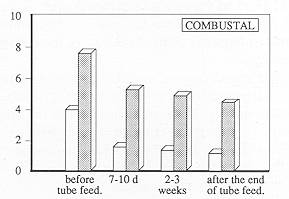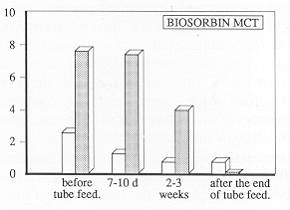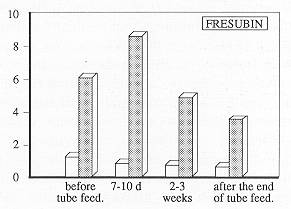| Ann. Medit. Burns Club - vol. 6 - n. 4 - December 1993
EFFICACY OF VARIOUS ALIMENTARY COMPOUNDS IN PROBE
ENTERAL NUTRITION OF BURN PATIENTS
Alexeev A.A., Saets T.L., Tarassov AN., Lavrov V.A.,
Melnikova TA.
A.V. Vishnevsky Institute of Surgery, Moscow, Russia
SUMMARY. Alimentary
compounds of natural homogenized products (Combustal, Russia) and mixtures of the formal
diet group (Biosorbin-MCT Pfrimmer-Cabi/Germany and Fresubin/Germany) used for
hyperalimentation of burn patients proved to be highly effective. The patients showed
weight gain, decrease of tissue protein dissociation, inhibition of destructive processes,
and activization of protein biosynthesis in the organism. In particular, Fresubin exerted
a more pronounced influence upon activization of the anabolic processes; Combustal was
more effective against dystrophic processes in muscle tissue; and Biosorbin/MCT
drastically inhibited phospholipatic activity.
Introduction
Artificial alimentation is used
either when a patient cannot or will not take food for some reason or when the amount of
alimentary products necessary is so high that it cannot be supplied by peroral
alimentation.
All this can occur in patients with full-thickness thermal burns. Grave metabolic
disturbances and pronounced deficiency of plastic and energetic resources demand
compensation by high-calorie balanced alimentary products. Peroral feeding is sometimes
impossible because of facial bums, loss of appetite and dyspeptic disorders. In these
cases artificial alimentation (at least as complementary) is undoubtedly indicated.
Parenteral infusion of the various amino acid, fat and carbohydrate solutions is also
possible but less advisable because it is intended for a shorter period of time than is
necessary for bum treatment. It can scarcely supply the high caloric demand, and sometimes
causes grave complications. It is also rather expensive.
There are many compounds for artificial alimentation; these are infused via a nasogastric
probe at a slow speed with the help of a peristaltic pump. This type of alimentation is
preferable (4, 6, 9).
Materials and methods
We observed 219 patients with burns of the second,
third A, B and fourth degree, covering 20 - 80% T13SA (full-thickness burns: 10-65%). All
the patients received enteral probe nutrition under conditions of hyperalimentation (6).
For the supplementary enteral nutrition we used various groups of ready-made alimentary
compounds. Eighty patients received a Russianproduced polymer infusion, Combustal, made of
highly homogenized natural products. The Combustal compounds can be divided according to
composition into 4 groups: Combustal-1, meat-vegetable compound with cereals (5 types);
Combustal-2, cereal (5 types); Combustal-3, fruit-vegetable compounds (3 types);
Combustal-4, compounds with high protein content (2 types). Combustal compounds were
introduced via a thin nasogastric probe for a long period of time (up to 22 hours a day)
at a speed of 2-3 ml/min with the help of a Piton-101 portable PUMP.
Other alimentary compounds belonged to the group of formal diets. They were introduced
under the same conditions with the help of pumps produced by various companies. Within 24
hours the patients received 3,500 - 4,600 kcal in addition to ordinary food which provided
the necessary level of hyperalimentation.
Sixty-three patients received the liquid alimentary compound Biosorbin-MCT, produced by
the Pfrimmer-Cabi company. The compound is rich in semisynthetic triglycerides with the
medium length of the carbon chains of the fat acids. Such triglycerides are absorbed
without emulsion by the bile acids and decomposition by pancreatic lypase. Fat acids
released by microsomal lypase reach the blood and liver directly. The compound is also
enriched with linolenic acid. The protein in Biosorbin-NICT is represented by lactalbumin
and casein with the addition of sulphur containing amino acid of the Lcystine. The
carbohydrates are represented by the rnono-, oligo- and polysaccharide of starch.
Seventy-six patients received the alimentary compound Fresubin produced by the Fresenius
company. Fresubin is composed of the highmolecular proteins of milk and soybeans, with
necessary arnino acids. Fresubin also contains polyunsaturated fat acids and no
cholesterin, purine bases and lactose. The source of carbohydrate is soluble maize starch.
The compound is enriched with vitamins and mineral additions.
Probe hyperalimentation was indicated no later than 2 weeks after the trauma. Duration of
the hyperalimentation was on average 36 days. During treatment we controlled body weight,
anthropometric data, clinical blood analysis and the dynamics of the metabolic processes.
In the patients' blood we determined the content of the general protein and its fractions,
and pseudocholinesterase activity as an enzyme. The latter characterizes the
protein-synthetic function of the liver (8) concentration of general lipids (5), and the
activity of the phospholipases A and C which are the intracellular enzymes normally absent
in human blood (they damage the cellular membranes by destroying their phospholipide
layer) (3). We also analysed the daily excretion of urea, amino acid nitrogen (7),
creatinine and creatine (5). The nitrogen balance was calculated according to the
formulary, taking into account the protein quantity infused in the organism.
Results
Enteral hyperalimentation was well
endured by the patients. The prolonged positioning of the probe in the nasopharynx was not
accompanied by painful sensations, it did not disturb nasal respiration and normal peroral
feeding, and none of the patients had dyspeptic disorders. On the contrary, prolonged
probe hyperalimentation stimulated oral food taking. In the process of enteral nutrition
the patients reported the sensation of satiety, cheerfulness and comfort, they slept
better, and were less irritated and in better spirits.
We paid special attention to the dynamics of the metabolic processes.
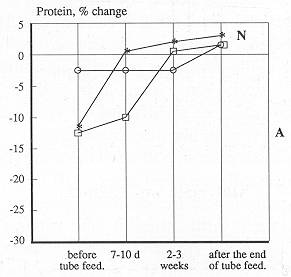 |
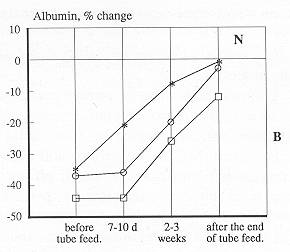 |
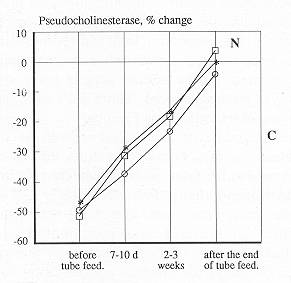 |
| Fig. 1 A-B-C Dynamics of protein, albumin content
and pseudocholinesterase activity in the blood of the bum patient in enteral probe
nutrition with compounds. Continuous line with asterisk: Fresubin; line with squares:
Biosorbin-MCT; line with circles: Combustal. The differences are shown only if they are
statistically true (p<0.05). |
|
Fig. 1 shows the content of protein
and albumin and the activity of the pseudocholinesterase in the blood of burn patients
treated by Combustal (1st group), Biosorbin-NICT (2nd group) and Fresubin (3rd group). For
better comparison of efficacy all alterations in dynamics are expressed in percentages of
the initial level. Fig. 1 (A) shows that the initial protein content in serum was
decreased in all the patients. We did not observe marked hypoproteinaemia, although
protein concentration in the serum showed a 2-12% decrease compared to the lower norm
limit and approached the normal level within 2-3 weeks after the beginning of the
alimentation. The normal protein level in the serum was reached earlier - within 7-10 days
- only in the case of treatment with Fresubin.
The albumin content in blood showed the same differences, but they were more distinct.
First of all it was found that the initial albumin content (gll) in the serum of burn
patients was much lower (37-43% from the lower norm limit) than the general protein
content, which could be supplemented by an intensified synthesis of the "inflammatory
proteins". Within 7-10 days the albumin concentration in the serum did not reach
normal values. However when Combustal and Biosorbin-MCT were used it remained on the
initial level; with Fresubin the albumin concentration remained decreased (37% compared to
21 %) (Fig. 1 B).
The initial very low activity of pseudocholinesterase slowly approached the lower norm
limit in the process of enteral hyperalimentation (Fig. 1).
The assumption of a possible supplementary influence of the nutrients on the catabolic
processes is to some extent illustrated by the data shown in Fig. 2. The graphs show (Fig.
2 A) that the negative nitrogen balance already approached zero within 7- 10 days after
commencement of artificial alimentation and in 2-3 weeks was expressed in positive values.
We did not observe significant differences in the action of the various nutrition
compounds. Amino acid excretion through the urine (Fig. 2 B) was significantly reduced
after 7-10 days, which showed inhibition of the catabolic processes. High creatine content
in the urine of bum patients (Fig. 2 Q testified to the significant disturbances of the
muscle metabolism and the prolonged dystrophic processes which persisted even after
treatment. The most marked reduction in creatine excretion took place when Combustal was
used, i.e. when full-value natural homogenized alimentation was infused into the organism.
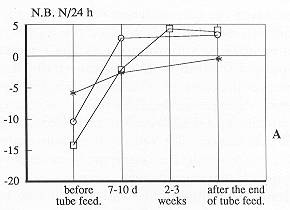 |
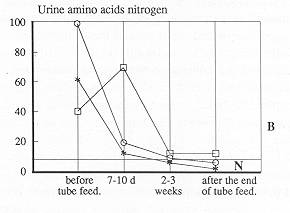 |
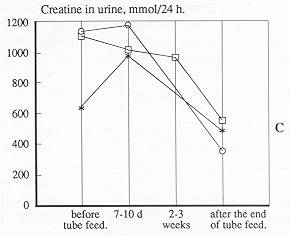 |
| Fig.
2 A-B-C Dynamics of nitrogen balance and excretion of the amino acids and
creatine in bum patients in probe enteral nutrition. Symbols as in Fig. 1. |
|
The content of the general lipids in the serum was decreased only in some very critically
burned patients, and the average initial values were within the norm. During the first
weeks of hyperalimentation the level of the general lipids remained stable, but at the end
of the treatment their concentration increased. The most significant increase was in the
group treated with Biosorbin-NITC (initial value: 5.2 g11; at end of treatment: 8.2 gjl).
The influence of Biosorbin-MCT was most marked in relation to phospholipase activity. It
is known that normally the activity of these enzymes in the blood cannot be detected, but
in bum patients, as a rule, we observed high activity of phospholipase A and C in the
serum. Infusion of the full-value nutrients into the organism inhibited phospholipase
activity at once (Fig. 3), gradually reducing it to trace activity. Biosorbin-MCT had the
most marked action: the activity of phospholipase C disappeared in the blood of all
patients, few of whom showed any activity of phospholipase A (average value 0.4).
Correction of the metabolic process and elimination of the shortage of plastic materials
influenced the general state of the organism and the wound process. One of the indices of
the state of the general organism is the dynamics of body weight.
The Table shows that patients with no probe
hyperalimentation had considerable weight loss. Under conditions of hyperalimentation,
after 7-10 days the weight loss was less and there was even a tendency for weight gain.
After 2-3 weeks of probe enteral nutrition we observed a marked weight gain which reached
significant values at the end of treatment. The most marked gain was after treatment with
Combustal and Fresubin, which correlated to the corresponding data of the dynamics of the
metabolic processes.
The wound process was also improved by probe hyperalimentation, the wounds being ready for
autodermoplasty 3-5 days earlier than in the control group. In this respect we did not
observe any differences in the action of the tested compounds.
Discussion
Improvement of the wound process
and body weight gain in severely burned patients are undoubtedly connected to the
elimination of the shortage of plastic resources, owing to the infusion of nutrients into
the organism and their good assimilation, which contributes to the correction of the
metabolic processes and the normalization of basic constant values.
Gradual normalization of the albumin concentration is influenced by the gradual activation
of the proteinsynthesizing function of the liver with the intensive infusion of plastic
material.
We cannot however exclude the influence of other factors: the amino acid set optimal for
albumin synthesis (Fresubin), the influence on vascular permeability and exudative
proces9es in the wound that would avert protein withdrawal from the blood, and also the
possibility of inhibiting dissociation of the tissue proteins. Data on the excretion of
amino acid nitrogen and creatine confirm the last assumption. Some aspects should be
emphasized: infusion of all nutritional compounds reduced amino acid excretion, but most
markedly Fresubin. When Combustal was used the patients had a marked reduction of creatine
excretion. The latter is very important as it testifies to the favourable influence on the
dystrophic processes in the muscles which are always observed in the bum disease and are
difficult to correct (9). We thought it possible to assume that inhibition of the
intensive disintegration of tissue protein begins earlier when burn patients receive
hyperalimentation. It considerably promotes the anabolic processes.
In spite of the fact that we paid most attention to the processes of protein metabolism,
we should also consider the influence of the infusion of compounds on the lipid exchange.
At the end of hyperalimentation the concentration of the general lipids in all patients
reached the upper norm limit (the highest indices were in patients receiving
Biosorbin-MCT). Nutritional compounds exert considerable influence on the activity of
phospholipase - the enzymes destroy the phospholipids which are widely spread in the cell
membranes and protect the cell. The phospholipases not only destroy the phospholipid layer
of the biological membranes but also release toxic metabolites and fatty acids, promoting
a series of conversions of arachidonic acid and its derivatives - the prostanoids of
various types. Phospholipase activity is absent in the blood of healthy human beings. The
source of the phospholipases A and C in the blood of burn patients is apparently destroyed
cells in the burned area, and possibly not only in this region (2).
We cannot exclude the possibility that the phospholipases were activated by the calcium
ions or free oxygen radicals in intensive free-radical processes in burn patients and by
other metabolites which are formed in burns under favourable conditions (1). The
favourable fact is that infusion of full-value nutrients into the organism eliminated
activity of the phospholipases. We should further study the fact that Biosorbin-MCT
enriched by medium-chain fat acids is the most effective.
RESUME. Les composés
alimentaires des produits naturels homogénéisés (Combustal/Russie) et les préparations
du groupe des diètes formelles (Biosorbin-MCT Pfrimmer-Cabi/Allemagne et
Fresubin/Allemagne) utilisés pour l'hyperalimentation des patients brûlés se sont
révélés très efficaces. Les patients ont manifesté une augmentation du poids, une
diminution de la dissociation protéique tissulaire, une inhibition des processus
destructifs, et une activation de la biosynthèse protéique de l'organisme. En
particulier, le Fresubin exerçait une influence plus marquée sur l'activation des
processus anabolisants; le Combustal était plus efficace contre les processus
dystrophiques du tissu musculaire; et le Biosorbin/MCT inhibait sévèrement l'activité
de la phospholipase.
BIBLIOGRAPHY
- Arturson G.: Pathophysiology of the burn wound.
Ann. Chir. et Gynecol, Finland, 69: 178, 1980.
- Kusin M.L, Sologub V.K., Tarassov A.V., Zaets T.L.:
Efficacy of probe alimentation in patients with brun trauma. Clin. Med., 2: 44-54,1986.
- Borodina N.A.: Significance of phospholipase
activity in the estimation of the wound process in children. Vestnik chirurgii, 4: 84-7,
1985.
- Moore S., Stein W.: Photometric Ninhydrin method of
amino acids. J. Biol. Chem., 176: 367, 1948.
- Habermann E, Hardt K.: A sensitive and specific
plate test for the quantitation of phospholipases. Analyt. Biochem., 50: 163-73, 1972.
- Vincent D., Segonzag G.: Adaptation plastique de la
méthode de Hestrin en dosage de la "pseudo-cholinestérase sérique". Ann.
Biol. Clin., 16: 227, 1958.
- Jacobs L., Kock M., van der Merwe A.E.: Oral hyper
alimentation and the prevention of severe weight loss in burned patients. Bums, 13: 154-8,
1987.
- Willats S.: Nutrition. Brit. J. Anaesth., 58:
201-22, 1986.
- Kornarov FT, Korovkin B.F., Menshikov V.V.:
Biochemical studies in clinics. Medicine: 286, 1976.
|






